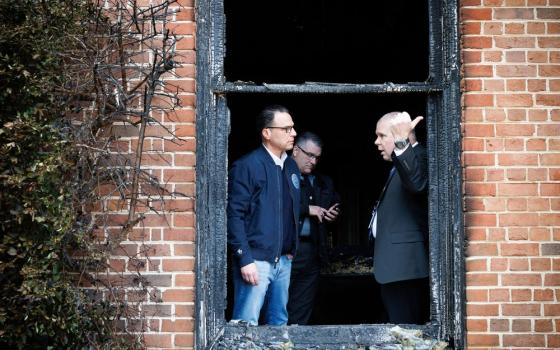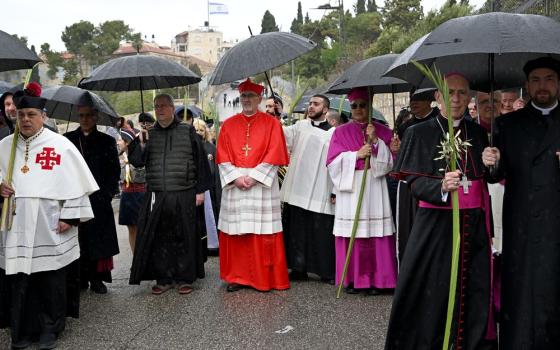Pope Francis has substantially and significantly altered the process for those seeking annulments of marriages in the Catholic church, eliminating sometimes lengthy and redundant judicial procedures and empowering local bishops to make judgments on their own in “particularly evident” cases.
The changes -- announced at the Vatican Tuesday with release of two formal documents signed by the pope known as motu proprios -- reflect a decided and new shift in delegating power from the church’s central command to local prelates around the world.
They also may represent the most public difference yet between Francis and his predecessors John Paul II and Benedict XVI, who had widely sought to limit the number of annulments in fear of creating a sort of back-door divorce process for Catholics.
In a short introduction to the new changes, Francis explains that he wanted to balance the church’s timeless worry to provide for the salvation of souls with “the enormous number of faithful that … too often are detached from the juridical structures of the Church at the cause of physical or moral distance.”
“In total harmony with these desires, I have decided to give with this Motu proprio arrangements that do not favor the nullifying of marriages but the promptness of the processes,” states Francis, so that “the heart of the faithful that wait for the clarification of their state may not be oppressed for a long time by the darkness of doubt.”
An annulment in the Catholic church is a decree from a church tribunal that a marriage between two persons was invalidly contracted. Such a decree is often sought by persons who are seeking to celebrate a different marriage.
The changes announced by Francis modify the procedures for obtaining annulments in two key ways: Eliminating a sometimes lengthy process requiring a second judgment on all annulment decisions and allowing local bishops a so-called “shorter” process to personally judge on cases considered particularly straightforward.
The changes also, in a new take on a since-abandoned practice, allow any first appeals of annulment decisions to be made at the local level instead of at the Vatican. Appeals from smaller dioceses will now be made at metropolitan archdioceses, which are the archdioceses that are normally closest to the diocese in question.
In his introductory letter for the decree altering the processes for the Latin-rite church -- the church community most recognizable throughout the world as Roman Catholic --the pontiff states that he recognizes the new procedures, especially those allowing decisions by bishops, might worry those concerned about Catholic teaching on the indissolubility of marriage.
But the pope says he wanted to offer the new process to bishops so that it can “be applied in cases in which the accused nullity of the marriage is sustained by arguments particularly evident.”
“It has not escaped me how an abbreviated judgment might put at risk the principle of indissolubility of marriage,” the pope continues. “Indeed, for this I wanted that in this process the judge would be composed of the bishop, that in the strength of his pastoral office is, with Peter, the best guarantee of Catholic unity in the faith and discipline.”
The Vatican announced the changes Tuesday by releasing the two official documents, given the Latin names of Mitis Iudex Dominus Iesus ("The Meek Judge, The Lord Jesus") and Mitis et misericors Iesus ("The Meek and Merciful Jesus").
The first document addresses and modifies the annulment procedure for the Latin-rite Code of Canon Law; the second for the canons governing the Eastern-rite Catholic churches. Both texts are currently available only in Latin and Italian.
The changes, signed by Francis on Aug. 15, are to go into effect Dec. 8, the opening day of the upcoming Jubilee Holy Year for Mercy and the 50th anniversary of the closing of the Second Vatican Council.
Francis’ decree for the Latin rite churches effectively updates and changes canons 1679-1691 in the church’s Code of Canon Law. The pope also attached to that decree 20 new “procedural rules” for bishops dealing with annulment cases, saying he wanted to offer them as “other instruments” for tools in their work on those matters.
Among other significant changes in the decrees: Francis also mandates that annulment procedures be made free of charge around the world, and also asks that bishops create some sort of structure in their dioceses that can guide and help separated Catholics considering divorce and/or annulment.
In his attached “procedural rules,” Francis gives examples of when a bishop might be able to decide an annulment on his own authority without using the normal process of the church tribunal.
Included in those examples: When there was a clear lacking of faith on the part of one of the persons consenting to the marriage, when one person was in another undisclosed relationship at the time of marriage, or when one party procured an abortion -- indicating that they were not open to the procreation of life.
Francis states in his preface to the Latin-rite decree that he hopes bishops will be close to the annulment processes in their dioceses so that they can offer “a sign of conversion of the ecclesiastical structures, and do not leave the judicial function in matrimonial matters completely delegated to the offices of the curia.”
The pontiff also states that he is allowing appeals of annulment decisions to be made to the metropolitan archdioceses as “a distinctive sign of the synodality of the Church.”
Announcement of the changes of the annulment procedures comes less than a month before the opening of a special global meeting of Catholic bishops, known as a synod, at the Vatican Oct. 4-25.
Francis has called two back-to-back synods for 2014 and 2015, to focus on issues facing families in contemporary society. The discussions have centered partly on the Catholic church’s pastoral practice towards those who have divorced and remarried without first obtaining annulments, who are currently prohibited from taking communion in the church.
Reform of the annulment process also comes with unusual speed for the Vatican, as the pope only first appointed a commission to study the matter in August 2014.
Francis states in his preface to the Latin-rite decree that he is partly making the changes to the annulment process on the suggestion of the bishops at the 2014 synod, who he says “requested more rapid and accessible processes.”
The pontiff’s decision to remove the until-now necessary, and sometimes lengthy, second judgment on all annulment decisions echoes an ability the U.S. Catholic bishops had from 1970-83, when they were allowed by the Vatican to dispense that obligation for certain cases.
That ability -- which was sharply criticized by some at the Vatican who thought the U.S. bishops were applying the dispensation too liberally -- was removed with the publication of the 1983 edition of the Code of Canon Law.
The number of annulment procedures initiated in the U.S. has dropped sharply in recent decades. According to the Center for Applied Research in the Apostolate (CARA) at Georgetown University, the processes initiated in the U.S. went from 60,691 in 1984 to 23,302 in 2014.
At a Vatican press conference announcing the annulment changes Tuesday, one church prelate said they represented the most substantial changes to the church's marriage law in centuries.
Msgr. Pio Vito Pinto, dean of the Vatican's highest appellate court, said they are probably the biggest changes to the church's marriage law since the pontificate of Pope Benedict XIV, who led the Catholic church from 1740-1758.
[Joshua J. McElwee is NCR Vatican correspondent. His email address is jmcelwee@ncronline.org. Follow him on Twitter: @joshjmac.]




